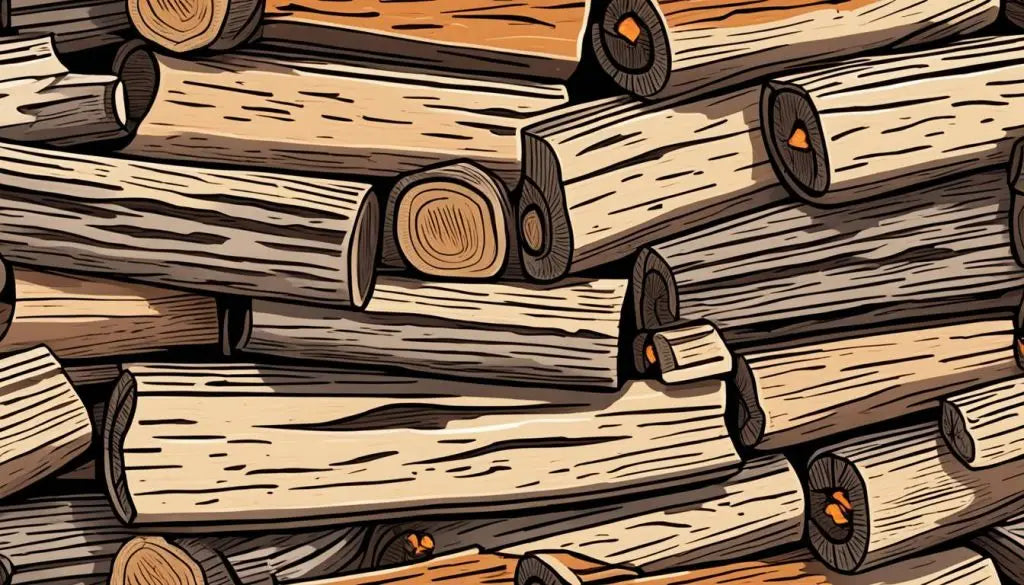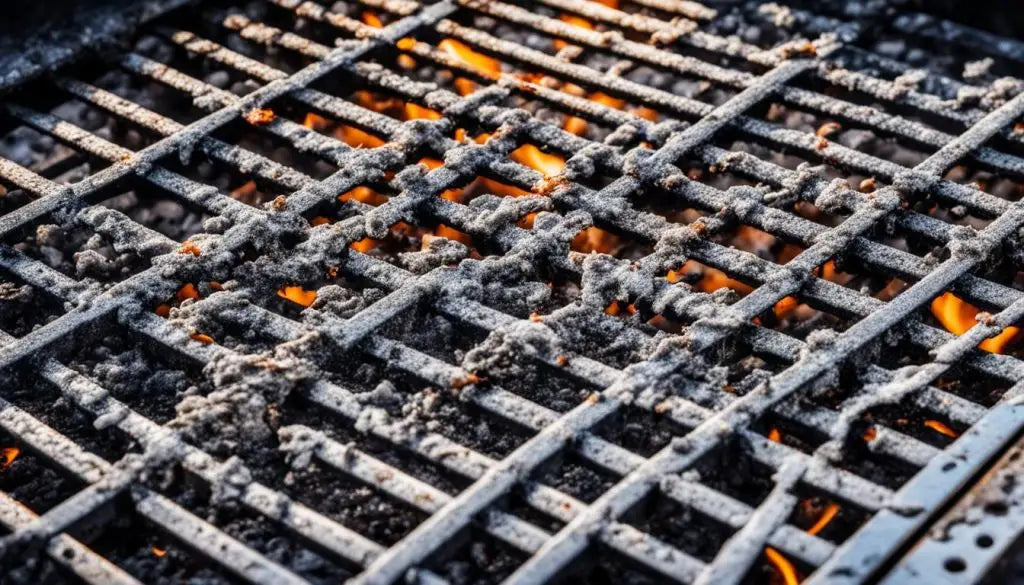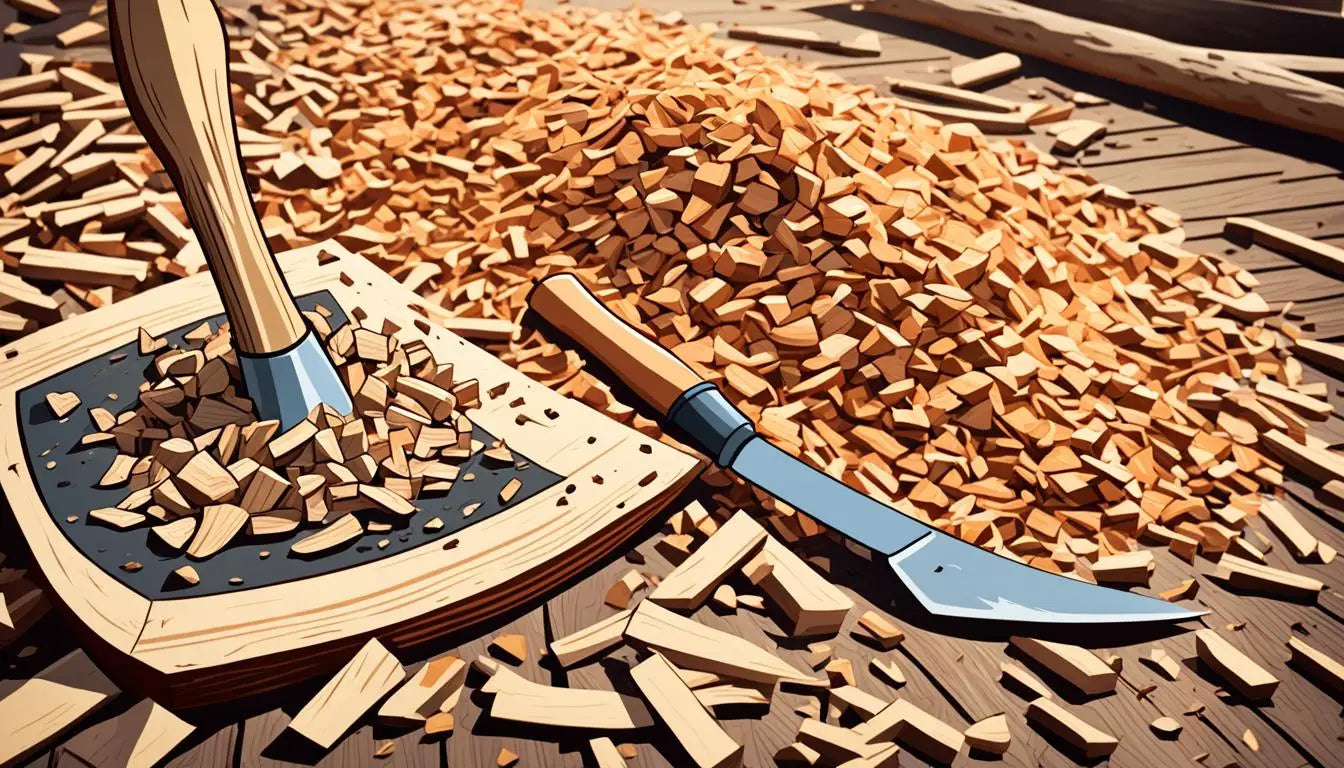Is your barbecue flavour all it could be? It's not just about the seasoning and sauces. The way you prepare your wood plays a big part in the smoky taste. With the British summertime around the corner, learning how to ready your wood for BBQ is key. Choosing the right wood, like apple for its light smoke flavour, is crucial for the perfect barbecue aroma.
Barbecue lovers are now preferring fist-sized wood chunks for their grills. These chunks give off smoke slower and for longer, making your meats and seafood taste better. But where do you learn how to upgrade your BBQ skills? You can find essential barbecuing tips and tricks to help you become the ultimate grill master. This includes choosing the best grills, using sustainable British charcoal, and picking natural firelighters.
Why not start your preparation early for an easy dining outdoors? Or try new flavours like locally farmed king prawns or even offal? It’s all about trying different tastes that wood prep can offer. Every BBQ expert knows that the key to great grilling is in the little details of how you prepare.
Choosing the Right Wood for Your Barbecue
Knowing how different woods affect your barbecue's taste is key for any BBQ lover. With many choices available, choosing the right wood for BBQ can turn a regular grill session into something special. This section explains why hardwood is often considered the best wood for BBQ. It also touches on how specific woods enhance your food’s flavour.
Benefits of Hardwood Over Softwood for BBQ
When talking about benefits of hardwood over softwood for BBQ, we start with how dense they are. Hardwoods like oak and hickory burn longer and hotter because they are more compact. This means your cooking temperature stays even. This even heat is crucial for both slow cooking and searing.
Characteristics of Kiln-Dried Wood for Enhanced Flavour
Kiln drying wood takes out moisture, making it light quickly and burn steadily. The characteristics of kiln-dried wood for enhanced flavour are ideal: You get less smoke and a clean burn. This clean burning means your food gets a lovely wood taste without the bitterness of too much smoke.
Best Wood Species for a Flavourful BBQ
Choosing the right wood isn’t just about the type, but also the species. The best wood species for a flavourful BBQ depend on the meat and the tastes you want. Here’s a quick guide on some top choices and what they bring to your BBQ:
| Wood Species | Flavour Profile | Best Paired With |
|---|---|---|
| Hickory | Rich and smoky | Red meats and pork |
| Maple | Sweet and subtle | Poultry and vegetables |
| Cherry | Fruity and mild | Chicken and cheeses |
| Oak | Medium smoky | Beef and sausages |
| Apple | Sweet and fruity | Pork and poultry |
Finding the perfect BBQ wood means looking for quality and how well it goes with your food. Going for hardwood, especially if it's kiln-dried, promises a better tasting experience. Each type of wood has unique flavours to offer. Your job is to pick the one that complements your dishes the best.
Wood Preparation Tips for BBQ
Choosing the right wood is the start of your BBQ mastery journey. Ensuring your wood is dry, seasoned, and stored correctly will make your grilling much better. Here are key tips for preparing BBQ wood, aimed at making you a top outdoor chef.
Drying: Fresh wood has a lot of moisture, leading to unwanted smoke and soot. Dry wood properly to avoid this. For best burning, wood should have less than 20% moisture. Stack it in a dry, airy place for six months before using it to BBQ.
Seasoning: Drying and seasoning work together. Seasoning brings out the wood's aromatic qualities, adding a smoked taste to your food. Splitting the wood helps it season faster by exposing more surface area, which lowers moisture more quickly.
Cutting: Cut your wood to suit your grill size and desired heat intensity. Use larger pieces for slow cooking and smaller ones for fast, high heat. Even-sized pieces burn more evenly.
Storing: Keep your wood dry and seasoned by storing it off the ground. Cover the top but let air flow around it. This protects the wood from the elements and keeps it ready for BBQ.
To perfect your BBQ, follow these wood preparation steps. They will help you achieve the ideal taste and heat control for a memorable meal. Start prepping now and enjoy the benefits at your next outdoor gathering.
Optimising Heat: How to Arrange Charcoal for Ideal Cooking
To master barbecuing, you need more than just seasoning skills. Arranging charcoal correctly is crucial for the best cooking results. This is vital for any sized gathering, affecting your food's taste and tenderness greatly.
Direct vs Indirect Grilling Techniques
Knowing the difference between direct vs indirect grilling techniques is key for barbecue success. Direct grilling puts charcoal right under the food for a hot cook, great for searing. But, indirect grilling uses the heat around the food. This slow cooks thick cuts without burning the outside.
Properly Setting Up Coals for Consistent Temperatures
Setting up coals for consistent temperatures requires accuracy. It's important for even cooking and flavourful, juicy food. The right setup lets you manage the heat, either for intense searing or gentle cooking.
Tips for optimising heat distribution include creating different heat zones on the grill and using techniques like the two-zone fire or the snake method.
Here's a guide to various charcoal layouts for different BBQ dishes:
| Grilling Technique | Charcoal Layout | Cooking Temperature | Ideal for Cooking |
|---|---|---|---|
| Direct | Even layer across grill | High | Steaks, burgers, kabobs |
| Indirect | Coals on one side | Medium to Low | Large roasts, whole chickens |
| Two-Zone Fire | Half grill with coals, half without | High to Moderate | Versatile cooking, best of both worlds |
| Snake Method | Charcoals arraged in a 'C' shape | Low | Slow-cooking, smoking meat |
Embracing Kiln-Dried Cooking Wood for Supreme Results
The journey to excellent BBQ heavily relies on the wood used. The transformation of simple ingredients into delicious meals is greatly enhanced by kiln-dried cooking wood. In the UK, BBQ lovers are seeing the clear benefits of this wood for top-notch results. Let's explore why kiln-dried wood is favoured for an improved barbecuing experience.

Kiln-dried wood has its moisture precisely controlled. This eliminates the guesswork associated with naturally seasoned wood. It burns consistently and lights up easily. This means less time spent struggling to start the fire and more time perfecting your BBQ skills.
Kiln-dried wood offers more than just convenience. It significantly impacts flavour. With less moisture, there's less smoke and cleaner burning. This enhances the food's natural tastes. Here are the key benefits of using kiln-dried wood for cooking:
- Less creosote build-up, avoiding bad tastes.
- Reaches higher temperatures for faster cooking.
- Reduces flare-ups for a safer BBQ.
Kiln-dried wood is the top pick for achieving incredible BBQ flavours. Now, let’s compare it to naturally seasoned wood:
| Kiln-Dried Wood | Naturally Seasoned Wood |
|---|---|
| Consistent low moisture content | Variable moisture content |
| Quick and easy ignition | May need more effort to light |
| Clean burn with less smoke | Possible more smoke and impurities |
| Higher cooking temperatures | Usually burns cooler |
| Less flare-ups | More likely to burn unevenly |
Choosing kiln-dried cooking wood is a smart move for BBQ enthusiasts. Its qualities ensure a dependable start for flavourful dishes. Impress your guests and satisfy keen taste buds. As summer approaches, remember that the best grilling starts with selecting the right wood.
Smoking Like a Pro: Enhancing Flavours with Prepped Wood
Turning a BBQ into a culinary masterpiece starts with smoking. The trick? Preparing your wood properly. To smoke like an expert, you need to know about soaking wood. This step makes your BBQ smell amazing and boosts the taste of your food.
The Lowdown on Wood Soaking for Smoking Perfection
Firstly, soaking wood is crucial. It makes the wood burn slower and smoke better. Soaking wood chips or chunks means they smoulder, not burn up fast. This slow burn gives your food a smoky taste without overpowering it.
How Long Should You Soak Your Wood Chips or Chunks?
How long you soak your wood matters a lot. For wood chips, 30 minutes to an hour is enough. They soak up water fast. But bigger wood chunks need more time, about one to two hours. Watching how long you soak the wood ensures you do it just right.
For those looking to perfect their soaking technique, here's a handy table:
| Wood Type | Soak Time for Chips | Soak Time for Chunks |
|---|---|---|
| Hickory | 1 hour | 2 hours |
| Apple | 45 minutes | 1.5 hours |
| Oak | 30 minutes | 1 hour |
| Mesquite | 30 minutes | 2 hours |
But beware of soaking too much. Too much moisture can make too much smoke. That can hide the lovely tastes of your food. So, stick to the recommended soaking times.
Trying different soaking times and woods can help you find the best taste. Follow these tips and you're on your way to being a BBQ genius. With the right soaked wood, your BBQ will be unforgettable.
Maintaining your Grill: Essential Tips for Wood and Charcoal Care
Having a great barbecue isn't just about the food or how you cook it. It also depends on taking good care of your grill. By looking after your grill and using the right wood and charcoal care, you make it last longer. This also means better tasting food every time. Let's look at how to get rid of ash and clean your grill properly. We will also see how to store your wood correctly.
Effective Ash Disposal and Grill Cleaning Practices
It's vital to get rid of ash and clean your grill after it cools. First, take the ash catcher off your grill and throw away the ash safely in a metal bin. Then, clear away any left behind ash and bits. Use a special grill brush to clean the grates. If you want a thorough clean, take the grill apart. Soak its pieces in soapy water, then rinse and dry them before putting it back together.

Storage Solutions for Seasoned and Kiln-Dried Woods
It's just as important to store your wood properly to keep it dry and effective. Your wood should be kept in a dry and airy place to stop mould and rot. If you're keeping wood outside, use a wood shed or a covered rack. Make sure your wood isn't touching the soil to avoid moisture getting in.
- Keep seasoned wood separate from kiln-dried pieces to preserve their distinct moisture levels.
- Periodically check your wood supply for pests, and reorganise it to maintain good air flow.
- Make use of breathable covers rather than plastic tarps which can trap moisture.
By following these steps for disposing of ash, cleaning your grill, and storing your wood, you ensure your grill is always ready. Good care of your grill sets the stage for tasty BBQs in the future.
Ensuring Food Safety with Correct Wood Preparation
When you have a barbecue, making sure the food is safe is just as important as getting that smoky taste right. It starts with preparing your wood the right way. This is a key step that some new pitmasters might miss. The right wood prep ensures a steady flame and keeps your food free from bad bacteria and chemicals.
Monitoring Cooking Temperatures with Quality Thermometers
Keeping an eye on the cooking temperatures is key for safe BBQ dishes. A good thermometer makes sure your meats are fully cooked. It shows you've hit the needed temperatures to kill off any germs. Let's look at how using the right thermometers makes your barbecue safe and fun:
- Place the thermometer in the thickest part of the meat, away from bones and fat.
- Use instant-read thermometers for quick checks and leave-in thermometers for continuous monitoring.
- Regularly calibrate thermometers to ensure accuracy and precision.
Interpreting the Signs of Perfectly Cooked Meats
Getting meats just right means more than reaching a certain temperature. We need to watch how the meat changes. Look for changes in texture, colour, and moisture to tell if it's done. Here's a guide:
| Meat Type | Visual Cue | Internal Temperature |
|---|---|---|
| Beef Steak | Deep brown crust, warm and pink centre | 52-57°C for Medium Rare |
| Chicken Breast | Opaque throughout, juices run clear | At least 74°C |
| Pork Ribs | Meat shrinks back from bones | 63-71°C for Well Done |
To wrap up, a top-notch barbecue comes from careful wood prep and close watch on cooking. Keeping safety in mind and using thermometers well makes for a winning BBQ. It's both tasty and safe.
Conclusion
The history of cooking has deeply influenced society and culture. Preparing wood for BBQ plays a crucial role in cooking. We've seen how from early humans using fire to today's BBQ, cooking has evolved.
Wood selection is key for BBQ success. It connects us to our history, just like the first fires did. Modern BBQing brings out amazing flavours thanks to the right wood.
Future BBQ techniques will focus on taste, texture, and nutrition. Choosing and preparing BBQ wood correctly is essential. It respects our culinary past. This guide aims to improve your BBQ skills and deepen your love for cooking.

